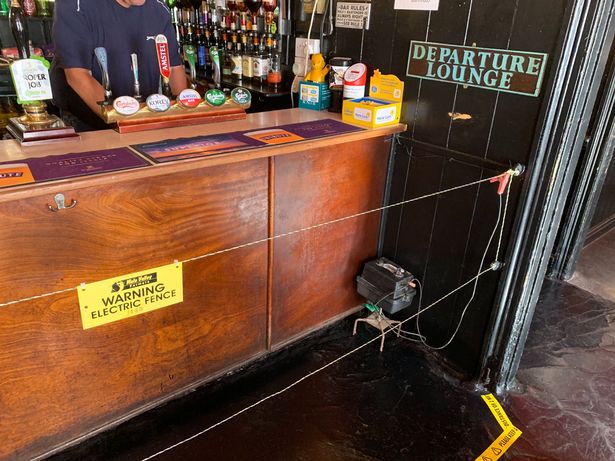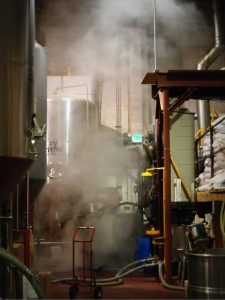 Achy. A bit from leaving the window open all night despite the forecast of quite cooler air. And me swimming in the big lake when its no longer quite so warm. Winter is coming. I’ve been in the lake maybe seven or ten times over the last few weeks. How long will it last? I grew up swimming in forest rivers as well as the North Atlantic Ocean back home in Nova Scotia. Lakes were always a bit stagnant by comparison. Folk call that “wild swimming” these days. I just call it swimming. Who knew the big water in the nearby big lake would be so big? Beach sand in the car. Beach toys in the trunk. Battered and beaten and happy am I.
Achy. A bit from leaving the window open all night despite the forecast of quite cooler air. And me swimming in the big lake when its no longer quite so warm. Winter is coming. I’ve been in the lake maybe seven or ten times over the last few weeks. How long will it last? I grew up swimming in forest rivers as well as the North Atlantic Ocean back home in Nova Scotia. Lakes were always a bit stagnant by comparison. Folk call that “wild swimming” these days. I just call it swimming. Who knew the big water in the nearby big lake would be so big? Beach sand in the car. Beach toys in the trunk. Battered and beaten and happy am I.
First off, before the snow blows, Retired Martin has taken us on a trek to a pub in a lovely traditional thatched roof village in Devon, the Globe Inn in Beaford:
…turns out to be the most crafty of any place I visited in Devon. Plain but welcoming, a good all-rounder whose GBG credentials are a bit mystifying till you taste the beer. That little fridge on the right (below) was packed full of 10% DIPAs and mango sours…
 Last weekend, I listened to a repeat of a short piece on the NPR radio show TTBOOK on the changes for the worse that have been imposed upon Bourbon County Stout through the sale of Goose Island to evil big industrial beer. It was particularly gratifying to see guest Josh Noel demonstrating the “nostril in the glass” technique I have been advocating for for about a decade and a half. Not unrelated but to the contrary, Mike reminded us on Twitter of the upside of the buy-out of craft:
Last weekend, I listened to a repeat of a short piece on the NPR radio show TTBOOK on the changes for the worse that have been imposed upon Bourbon County Stout through the sale of Goose Island to evil big industrial beer. It was particularly gratifying to see guest Josh Noel demonstrating the “nostril in the glass” technique I have been advocating for for about a decade and a half. Not unrelated but to the contrary, Mike reminded us on Twitter of the upside of the buy-out of craft:
You know when a brewery sells to the big guys and they say that it offers them more resources than they would have normally? This example shows that perfectly. Safe place for customers and their employees continue to have jobs. Just sayin.
Everyone’s favourite Midwest bar, the Olympic Tavern, that they have never visited had a rough bit of bad customer experience this week, something that highlights that during times of crisis some folk place having a beer and a Margarita high up on their priorities. Handled well. Along a similar vein, Pellicle has posted the tale of a Scottish drinking habit that, being Scots, I’ve never quite heard of:
The hauf an a hauf is traditional and modern at the same time. It’s a Scottish cultural institution we can be proud of: a combination in which to luxuriate, rather than down in pursuit of a buzz. The hauf an a hauf is about savouring both, two halves coming together to create something new, whole, and wholly wonderful.
There must be an alt-tartan reality that excluded the generations before me as the idea that there is some long pervasive history of buzz avoidance going on north of Gretna Green is news to me. Rather than suggesting it is a tradition, in 2014 TheBeerCast described the novelty in this way:
I guess the bottom line here is what do you want from a hauf and hauf? To get loaded, quicker? A US-style ‘Shot and a beer, Dolores’? Or to give a depth of flavour to each drink? It seems, judging from the conversation, that the way half and halves are being seen is changing, as a newer generation of beer/whisky fans indulge in the practice as a tasting exercise, rather than an end-of-shift exercise…
That makes more sense. That’s more in line with Great-Grannie Campbell between the wars being banned for life – a number of times – from the James Watt pub in Greenock even though she lived right above it. Or more likely because. Then the grandchildren being kicked out when they were sent to get a gill on her behalf.
More currently, Matt noted with some hesitancy the creation of something called the Small Brewers Forum in the UK. It is open to breweries:
The Small Brewers Forum has been formed to protect and preserve small British breweries and those who operate them. We have a successful and strong collective voice and campaign on behalf of our members to ‘fight for fairness’ in the industry. We take our campaigning to the highest level at national government as well as local government and within the brewing industry.
The published material indicates that the “only let small brewers join (sub-10000hL) so I can be sure that they represent what’s good for me without any of the big guys pulling the strings.” This makes a lot of sense to me. The numerical majority of brewers are small and have local markets. Their issues are very different from regionals and big craft. Here in Ontario, while there isn’t a second organization after OCB, the membership of that organization represents only the minority of the province’s brewers. Trade organizations structured on “craft” or geography make less sense than those with common issues based on scale.
In the ha ha dumb dumb news item of the week, Budweiser was caught echoing Eco*:
On Friday, the company wrote, in a now-deleted tweet, about two of their brands, Budweiser and Bud Light. “Reject modernity, embrace tradition,” the tweet read, telling consumers to enjoy the original beverage over it’s lower-calorie counterpart. Pictured were the sleek, modern-looking Bud Light can, along with the classic designed Budweiser beer. However, the seemingly simple message raised some eyebrows. One Twitter user, Joshua A.C. Newman, pointed out the origins of the text for the ad. “Are you deliberately quoting the first two elements of Umberto Eco’s 14 elements of Fascism?” he responded to the since-deleted tweet.
There’s that concept of “tradition” again. Calling card of the casually ahistorical.
And, as recommended by Andy, I signed up for the beer newsletter by David Infante – and was pleased to find out it was also a blog. There are a lot of beer blogs holding themselves out as online beer magazines and newsletters these days. It’s a bit sad that self-publishing is that little bit needy that it needs to hide itself behind odd labels and a thin veneer of exclusivity. Anyway, his latest blog post “Hire me, White Claw” caught my attention primarily as it confirmed what I should have known – this year’s trendy cooler White Claw is Canadian!!!** While Jordan mentioned it in passing in his recent post he did not hit me over the head with the fact. Never had one sip myself. Nope. So virtuous I am. Plus I have Pickled Green Bean Clamato for that.
Stan has been telling tales again – this time about new hops being named and brought to market:
By announcing a name for the experimental hop previously known as HBC 692 the company signaled she is her own brand. “We were getting very significant pull (demand),” said Jason Perrault, CEO and hop breeder for Yakima Chief Ranches. HBC is a partnership between YCR and John I. Haas. “We’ve seen the impact it can have in a beer. Unique, but appealing. It was just time to give it its own identity.” The name, Talus, is a nod to the talus slopes found in the Yakima Valley. She is a daughter of Sabro, the hop formerly known as HBC 438 and commercialized in 2018.
I’m not a hop spotter myself, preferring to drink and think about beer once made but it is interesting to see how in the hop trade these sorts of things matter. Mr Stange even admitted to having been aware of the name (before the name was released) by way of an embargoed press release – which made me wonder if new shoe lace tech also comes with embargoed press releases. You should also sign up for Stan’s newsletter Hop Queries to really keep up. It’s a blog he sends to you monthly by email.
Finally, Jeff posted a post on Wednesday about the brewing volume stats coming out of the Oregon Liquor Control Commission so far in this very odd year:
The Oregon Liquor Control Commission tracks the taxable barrels sold by Oregon breweries in Oregon. I’ve been watching to see when the June report would drop, because that will give us six months of data to see what kind of violence COVID-19 has done to breweries. The upshot: it’s been bad, but maybe not as bad as we might have guessed back in March. Thirteen of the top twenty breweries were down from this time last year, some substantially. But overall, the top 20 breweries were only down 2% from the same period in 2019.
While that is an average that is great news. If I could go back to myself five months ago, in the middle of the beginning of the stress of what was to come, and say “don’t worry it’ll only be 2% off” I’d be ecstatic. Now, it’s clear that it is an average and some are suffering more than that but for an economic snapshot that’s a pretty sweet picture.
In news of the ancient, Merryn gave me the heads up about a weekly web event put on by EXARC, “the ICOM Affiliated Organisation on Archaeological Open-Air Museums, Experimental Archaeology, Ancient Technology and Interpretation”:
Historical-archaeological Beer Brewers unite! We meet for a chat, this Saturday, 20:00h CET. It’s free, it’s open access and for anybody with a serious interest and / or experience with historic, archaeological craft brewing, anywhere in the world.
You sign up, too! Now!! I may be mowing as that’s mid-afternoon on the best day of the week. The heart of Saturday afternoon which is prep time for the heart of Saturday night.***
Here’s an interesting bit of news. An Albertan laboratory ran a study of beers entered into an awards judge-y thing to see if there were patterns in award giving outery:
The Raft Beer Labs analysis, published on its website, showed a few trends among medal-winning beers. Fresher beer was more likely to win an award. Medal winners were more likely to have a dry-finish than non-winners. Award-winning beers also tended to be clearer, with less turbidity than non-winners. Medal winners were also found to have lower free amino nitrogen levels and tended to be slightly higher in alcohol content than their target. The analysis also showed that both winners and non-winners were less bitter — measured in IBUs, or International Bittering Units — than the listed level, and both winners and non-winners had some microbial contamination, from wild yeasts or bacteria.
Interesting. Clearer, stronger and less bitter beers were preferred. The opposite of trendy low-alc murky hop bombs the blogs and micro blogs and photo blogs and podcast blogs and multi-author blogs are all talking about.
Finally, I am not sure I understand the point of this story. Why care about a brewery that many have written off? Why write and publish “Founders continues to defend its corporate culture”?
Done! For more of the good stuff but from a different view and in a range of blog formats, check in with Boak and Bailey most Saturdays, plus more at the OCBG Podcast on Tuesdays (listen as they shit on Belleville this week!) and sometimes on a Friday posts at The Fizz as well. And sign up for Katie’s weekly newsletter, too. Plus the venerable Full Pint podcast. And Fermentation Radio with Emma Inch. There’s the AfroBeerChick podcast as well! And have a look at Brewsround‘s take on the beer writing of the week. Not to mention Cabin Fever. And Ben has finally gone all 2009 and joined in with his own podcast, Beer and Badword.**** And BeerEdge, too.
*I know – excellent, right?
**Which is sorta like saying “Soylent Green is people!” in some circles.
***Yup.
****The greatest Great Lake is obviously Lake Ontario as it contains all the other Great Lakes.





 that good day which included the comment ” Jimmy hasn’t gone to bed after his night shift tarmacking the roads.” Nice. I’m on Team Jimmy. Jeff
that good day which included the comment ” Jimmy hasn’t gone to bed after his night shift tarmacking the roads.” Nice. I’m on Team Jimmy. Jeff 



 Go. Go put on your 45 of Don McLean singing “American Pie,” his lament for the milestones marking the ends of innocence during the first two decades of the rock ‘n’ roll era. Go put it on and have have a good cry because that’s sorta what happened this week. BeerAdvocate got
Go. Go put on your 45 of Don McLean singing “American Pie,” his lament for the milestones marking the ends of innocence during the first two decades of the rock ‘n’ roll era. Go put it on and have have a good cry because that’s sorta what happened this week. BeerAdvocate got 

 Yuletide. Its been busy so far this month but after one last late evening meeting for work tonight I think I might be sliding into Yule proper. As I mentioned a few weeks ago, the days of the Christmas Yuletide Hogmanay Kwanzaa and Hanukkah Beery photo contest may be well past us but the archives go on and on. To the left is
Yuletide. Its been busy so far this month but after one last late evening meeting for work tonight I think I might be sliding into Yule proper. As I mentioned a few weeks ago, the days of the Christmas Yuletide Hogmanay Kwanzaa and Hanukkah Beery photo contest may be well past us but the archives go on and on. To the left is